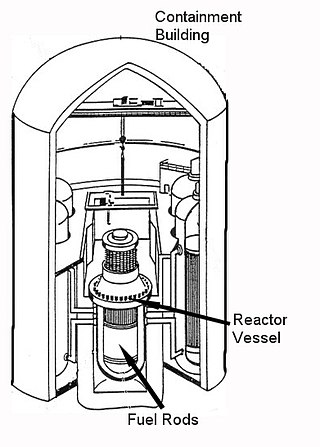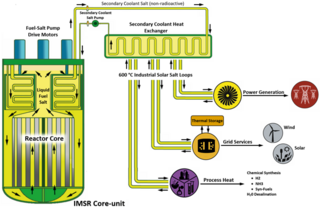Related Research Articles

A nuclear reactor is a device used to initiate and control a fission nuclear chain reaction or nuclear fusion reactions. Nuclear reactors are used at nuclear power plants for electricity generation and in nuclear marine propulsion. Heat from nuclear fission is passed to a working fluid, which in turn runs through steam turbines. These either drive a ship's propellers or turn electrical generators' shafts. Nuclear generated steam in principle can be used for industrial process heat or for district heating. Some reactors are used to produce isotopes for medical and industrial use, or for production of weapons-grade plutonium. As of 2022, the International Atomic Energy Agency reports there are 422 nuclear power reactors and 223 nuclear research reactors in operation around the world.

The Three Mile Island accident was a partial nuclear meltdown of the Unit 2 reactor (TMI-2) of the Three Mile Island Nuclear Generating Station on the Susquehanna River in Londonderry Township, near the capital city of Harrisburg, Pennsylvania. The reactor accident began at 4:00 a.m. on March 28, 1979, and released radioactive gases and radioactive iodine into the environment. It is the worst accident in U.S. commercial nuclear power plant history. On the seven-point logarithmic International Nuclear Event Scale, the TMI-2 reactor accident is rated Level 5, an "Accident with Wider Consequences".

A pressurized water reactor (PWR) is a type of light-water nuclear reactor. PWRs constitute the large majority of the world's nuclear power plants. In a PWR, the primary coolant (water) is pumped under high pressure to the reactor core where it is heated by the energy released by the fission of atoms. The heated, high pressure water then flows to a steam generator, where it transfers its thermal energy to lower pressure water of a secondary system where steam is generated. The steam then drives turbines, which spin an electric generator. In contrast to a boiling water reactor (BWR), pressure in the primary coolant loop prevents the water from boiling within the reactor. All light-water reactors use ordinary water as both coolant and neutron moderator. Most use anywhere from two to four vertically mounted steam generators; VVER reactors use horizontal steam generators.

A boiling water reactor (BWR) is a type of light water nuclear reactor used for the generation of electrical power. It is the second most common type of electricity-generating nuclear reactor after the pressurized water reactor (PWR), which is also a type of light water nuclear reactor.

The Nuclear Regulatory Commission (NRC) is an independent agency of the United States government tasked with protecting public health and safety related to nuclear energy. Established by the Energy Reorganization Act of 1974, the NRC began operations on January 19, 1975, as one of two successor agencies to the United States Atomic Energy Commission. Its functions include overseeing reactor safety and security, administering reactor licensing and renewal, licensing radioactive materials, radionuclide safety, and managing the storage, security, recycling, and disposal of spent fuel.

Indian Point Energy Center (I.P.E.C.) is a three-unit nuclear power plant station located in Buchanan, just south of Peekskill, in Westchester County, New York. It sits on the east bank of the Hudson River, about 36 miles (58 km) north of Midtown Manhattan. The facility has permanently ceased power operations as of April 30, 2021. Before its closure, the station's two operating reactors generated about 2,000 megawatts (MWe) of electrical power, about 25% of New York City's usage. The station is owned by Holtec International, and consists of three permanently deactivated reactors, Indian Point Units 1, 2, and 3. Units 2 and 3 were Westinghouse pressurized water reactors. Entergy purchased Unit 3 from the New York Power Authority in 2000 and Units 1 and 2 from Consolidated Edison in 2001.

The Millstone Nuclear Power Station is the only nuclear power plant in Connecticut and the only multi-unit nuclear plant in New England. It is located at a former quarry in Waterford. With a total capacity of over 2 GW, the station produces enough electricity to power about 2 million homes. The operation of the Millstone Power Station supports more than 3,900 jobs, and generates the equivalent of over half the electricity consumed in Connecticut.

Columbia Generating Station is a nuclear commercial energy facility located on the Hanford Site, 10 miles (16 km) north of Richland, Washington. It is owned and operated by Energy Northwest, a Washington state, not-for-profit joint operating agency. Licensed by the Nuclear Regulatory Commission in 1983, Columbia first produced electricity in May 1984, and entered commercial operation in December 1984.

A containment building is a reinforced steel, concrete or lead structure enclosing a nuclear reactor. It is designed, in any emergency, to contain the escape of radioactive steam or gas to a maximum pressure in the range of 275 to 550 kPa. The containment is the fourth and final barrier to radioactive release, the first being the fuel ceramic itself, the second being the metal fuel cladding tubes, the third being the reactor vessel and coolant system.

Spent fuel pools (SFP) are storage pools for spent fuel from nuclear reactors. They are typically 40 or more feet (12 m) deep, with the bottom 14 feet equipped with storage racks designed to hold fuel assemblies removed from reactors. A reactor's local pool is specially designed for the reactor in which the fuel was used and is situated at the reactor site. Such pools are used for short-term cooling of the fuel rods. This allows short-lived isotopes to decay and thus reduces the ionizing radiation and decay heat emanating from the rods. The water cools the fuel and provides radiological protection from its radiation.

The Economic Simplified Boiling Water Reactor (ESBWR) is a passively safe generation III+ reactor design derived from its predecessor, the Simplified Boiling Water Reactor (SBWR) and from the Advanced Boiling Water Reactor (ABWR). All are designs by GE Hitachi Nuclear Energy (GEH), and are based on previous Boiling Water Reactor designs.

The BN-600 reactor is a sodium-cooled fast breeder reactor, built at the Beloyarsk Nuclear Power Station, in Zarechny, Sverdlovsk Oblast, Russia. It has a 600 MWe gross capacity and a 560 MWe net capacity, dispatched o the Middle Urals power grid. It has been in operation since 1980 and represents an evolution on the preceding BN-350 reactor. In 2014, its larger sister reactor, the BN-800 reactor began operation.

Nuclear safety in the United States is governed by federal regulations issued by the Nuclear Regulatory Commission (NRC). The NRC regulates all nuclear plants and materials in the United States except for nuclear plants and materials controlled by the U.S. government, as well those powering naval vessels.

Small modular reactors (SMRs) are a class of small nuclear fission reactors, designed to be built in a factory, shipped to operational sites for installation and then used to power buildings or other commercial operations. The first commercial SMR was invented by a team of nuclear scientists at Oregon State University (OSU) in 2007. Working with OSU's prototype, NuScale Power developed the first working model, available to the US market, in 2022. The term SMR refers to the size, capacity and modular construction. Reactor type and the nuclear processes may vary. Of the many SMR designs, the pressurized water reactor (PWR) is the most common. However, recently proposed SMR designs include: generation IV, thermal-neutron reactors, fast-neutron reactors, molten salt, and gas-cooled reactor models.
The Energy Multiplier Module is a nuclear fission power reactor under development by General Atomics. It is a fast-neutron version of the Gas Turbine Modular Helium Reactor (GT-MHR) and is capable of converting spent nuclear fuel into electricity and industrial process heat.
Boiling water reactor safety systems are nuclear safety systems constructed within boiling water reactors in order to prevent or mitigate environmental and health hazards in the event of accident or natural disaster.
When the Fukushima Daiichi nuclear disaster began on 11 March 2011, reactor unit 4, 5 and 6 were all shut down. An explosion damaged unit 4 four days after the 2011 Tōhoku earthquake and tsunami. Damages from the earthquake and tsunami on unit 5 and 6 are relatively minor.

Unit 3 of the Fukushima Daiichi Nuclear Power Plant was one of the reactors in operation on 11 March 2011, when the plant was struck by the tsunami produced by the Tohoku earthquake. In the aftermath, the reactor experienced hydrogen gas explosions and suffered a partial meltdown, along with the other two reactors in operation at the time the tsunami struck, unit 1 and unit 2. Efforts to remove debris and coolant water contaminated with radiation are ongoing and expected to last several decades.

The Integral Molten Salt Reactor (IMSR) is a nuclear power plant design targeted at developing a commercial product for the small modular reactor (SMR) market. It employs molten salt reactor technology which is being developed by the Canadian company Terrestrial Energy. It is based closely on the denatured molten salt reactor (DMSR), a reactor design from Oak Ridge National Laboratory. It also incorporates elements found in the SmAHTR, a later design from the same laboratory. The IMSR belongs to the DMSR class of molten salt reactors (MSR) and hence is a "burner" reactor that employs a liquid fuel rather than a conventional solid fuel; this liquid contains the nuclear fuel and also serves as primary coolant.
References
- 1 2 3 Pooley, Eric (March 4, 1996). "Nuclear Warriors". Time . Archived from the original on September 4, 2009.
- 1 2 Shaw, William H. (2004). Business Ethics. pp. 267-268.
- ↑ Adam Bowles, Adam (October 2, 2000). "A Cry in the Nuclear Wilderness". Christianity Today .
- 1 2 "George Galatis, Nuclear Whistleblower". Time. March 4, 1996. Cover. Archived from the original on July 17, 2006.
- ↑ NRC Failure to Adequately Regulate - Millstone Unit 1 (Case No. 95-77I)